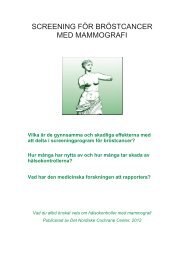1 Selective serotonin reuptake inhibitors (SSRI) â sales, withdrawal ...
1 Selective serotonin reuptake inhibitors (SSRI) â sales, withdrawal ...
1 Selective serotonin reuptake inhibitors (SSRI) â sales, withdrawal ...
Create successful ePaper yourself
Turn your PDF publications into a flip-book with our unique Google optimized e-Paper software.
130 M. Nielsen and P. Gøtzsche / An analysis of psychotropic drug <strong>sales</strong><br />
60<br />
Number of products/indications<br />
50<br />
40<br />
30<br />
20<br />
10<br />
0<br />
1983<br />
1985<br />
1987<br />
1989<br />
1991<br />
1993<br />
1995<br />
Year<br />
1997<br />
1999<br />
2001<br />
2003<br />
2005/06<br />
Indications<br />
Number of benzodiazepine product<br />
Fig. 4. Number of benzodiazepine products and indications.<br />
In contrast, we found a steep and linear increase in <strong>sales</strong> of specific neurotransmitter <strong>reuptake</strong> <strong>inhibitors</strong><br />
(N06AB and N06AX), which showed no signs of wearing off. This increase was mainly due to increased<br />
<strong>sales</strong> of <strong>SSRI</strong>s. Some of the indications for benzodiazepines and <strong>SSRI</strong>s are the same, but as the increase<br />
started several years later than the decrease in <strong>sales</strong> of benzodiazepines, the development cannot be<br />
explained merely by patients being transferred from one drug group to the other.<br />
The most likely explanation for the increase in <strong>sales</strong> is increased marketing pressure. The number of<br />
products on the market increased steeply, at about the same rate as the increase in <strong>sales</strong>, and involved<br />
an increasing number of companies so that in 2007, 23 different drug firms marketed <strong>SSRI</strong>s (Fig. 3).<br />
General practitioners were therefore exposed to a steeply increasing number of <strong>sales</strong> pitches from drug<br />
representatives recommending <strong>SSRI</strong>s for an increasing number of indications. A Danish study has shown<br />
that general practitioners in general receive a median of 19 visits from drug representatives during six<br />
months and that the drug industry uses a variety of methods to get their message across including gifts, drug<br />
samples and invitations to courses and meetings [12]. Marketing is also directed towards potential patients<br />
through disease awareness campaigns [13]. This is indirect marketing, as direct marketing for prescription<br />
drugs aiming at consumers or patients is not allowed in the European Union. Disease awareness campaigns<br />
focus on a specific disease and its symptoms, with a request to see a doctor and with a drug company as<br />
sender, sometimes together with a patient organisation.<br />
In 2007, the total <strong>sales</strong> of specific neurotransmitter <strong>reuptake</strong> <strong>inhibitors</strong> in Denmark, which has a<br />
population of 5.4 million people, amounted to about 75 million Euros. From the Danish Drug Statistics<br />
(2005–2009) it appears that two of these drugs were represented on the list of the 25 most sold drugs in<br />
Denmark, venlafaxine with total <strong>sales</strong> of 28 million Euro (14 million DDD) and escitalopram with total<br />
<strong>sales</strong> of 20 million Euro (20 million DDD). The widespread use of these expensive drugs suggests that





